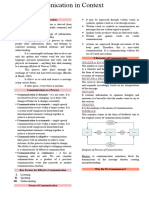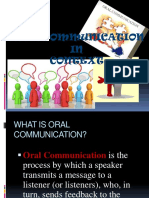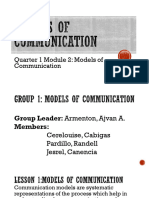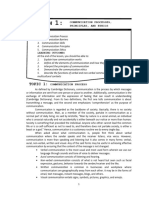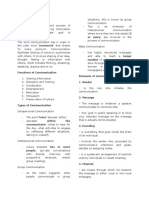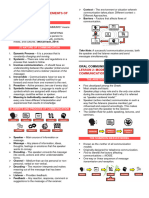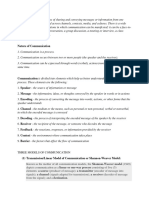0% found this document useful (0 votes)
59 views5 pagesOral Com
1. Communication is the process of sharing and conveying messages between people through various channels and contexts. It involves a speaker, message, encoding, channel, decoding, receiver, feedback, context, and potential barriers.
2. There are three main models of communication: the linear model which describes a one-way transmission of messages, the interactive model which incorporates feedback loops, and the transactional model which views communication as a cooperative process of shared meaning creation.
3. Breakdowns in communication can occur when barriers like physical, psychological, cultural, linguistic or physiological factors interfere with the clear understanding of messages between a sender and receiver. Strategies like being complete, concise, considerate, concrete, courte
Uploaded by
Davis PasuquinCopyright
© © All Rights Reserved
We take content rights seriously. If you suspect this is your content, claim it here.
Available Formats
Download as DOCX, PDF, TXT or read online on Scribd
0% found this document useful (0 votes)
59 views5 pagesOral Com
1. Communication is the process of sharing and conveying messages between people through various channels and contexts. It involves a speaker, message, encoding, channel, decoding, receiver, feedback, context, and potential barriers.
2. There are three main models of communication: the linear model which describes a one-way transmission of messages, the interactive model which incorporates feedback loops, and the transactional model which views communication as a cooperative process of shared meaning creation.
3. Breakdowns in communication can occur when barriers like physical, psychological, cultural, linguistic or physiological factors interfere with the clear understanding of messages between a sender and receiver. Strategies like being complete, concise, considerate, concrete, courte
Uploaded by
Davis PasuquinCopyright
© © All Rights Reserved
We take content rights seriously. If you suspect this is your content, claim it here.
Available Formats
Download as DOCX, PDF, TXT or read online on Scribd
/ 5

